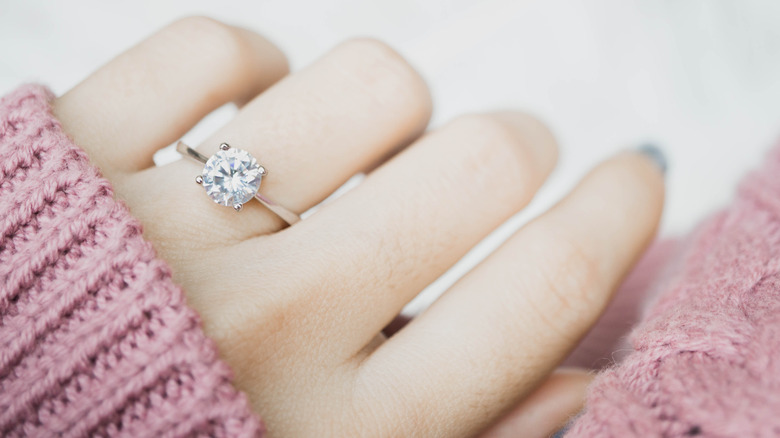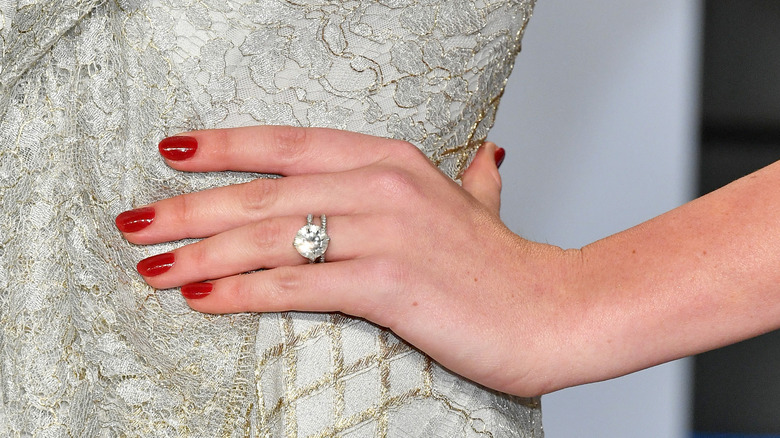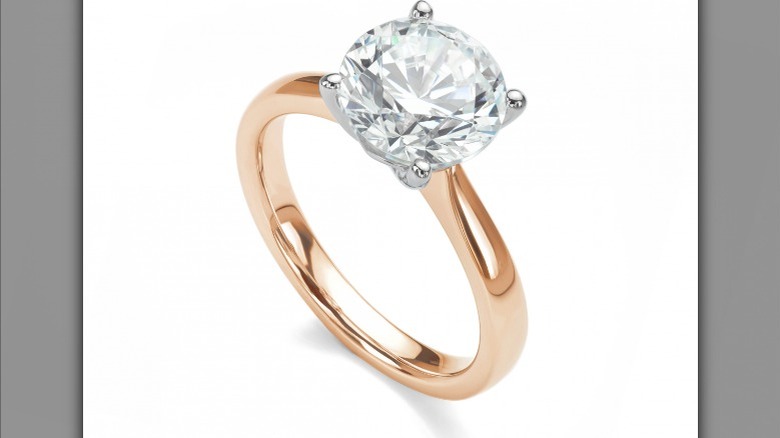The Best Cut For Your Engagement Ring May Be The Round Brilliant - Here's Why
Very few parts of a wedding endure past the last dance at the reception. The gown gets put into storage, the flowers wilt, the cake gets eaten. A photo or two might be framed, but the rest get cycled to the bottom of the couple's Insta feed after a few months. The big exception are the rings, which stay as a permanent reminder of the happy couple's commitment. The engagement ring, in particular, is the one that truly stands out. Whether it's a simple budget-friendly engagement ring or an over-the-top dazzler like the $8 million green diamond bauble Ben Affleck gave to J.Lo for their second go-round, that bit of bling is a perfect introduction to the happily-ever-after life.
There's a lot to take into consideration when choosing an engagement ring. Gold, white gold, or platinum band? Solitaire or multi-stone? And what type of stone? Alternate gemstones are becoming increasingly popular (though you might think twice before getting an opal, which is a very fragile stone), but diamonds are still a girl's (or guy's, or anyone's) best friend. According to a large survey from The Knot, a full 85% of respondents chose the classic sparkler for their ring, with more than half sporting a diamond center stone with smaller side stones.
Not surprisingly, the majority of those surveyed (41%) also said their ring features a round-cut diamond. While oval-cut stones are gaining in popularity, they're unlikely to unseat the classic round shape anytime soon — and there's a reason for that.
Round diamonds literally shine more
True, 2023 engagement ring trends are daring to go beyond the basic, with east-west rings and Toi et Moi two-stone rings on the rise. But the round-cut diamond isn't going anywhere anytime soon, and Kate Upton's engagement ring illustrates why. This simple cut is not only timeless, but it's also the main reason we refer to diamond rings as "sparklers."
The round brilliant cut was developed in 1919 using a mathematical formula to determine exactly how to give a diamond the best sparkle. The answer: 58 facets in a round shape reflect the most light, creating the stunning prism effect so coveted by jewelers and buyers alike. The simple design also makes it appealing either as a standout solitaire or the centerpiece to a fancier ring, such as a two- or three-stone design, a halo of smaller diamonds, or a band with pavé stones. If your budget doesn't accommodate a Kardashian-level ring, a round diamond still looks bigger than other cuts, especially if it's set with thin prongs that let most of the stone show.
This cut is scientifically most appealing
Apart from its brilliance and versatility, the round-cut diamond is popular for an interesting scientific reason. According to studies cited by BBC Science Focus, volunteers were more likely to choose shapes such as circles and ovals over squares and triangles, and to gravitate toward curved alphabet letters like S, C, and O.
We may actually be hard-wired to prefer curved shapes to angular ones: In brain-mapping tests, scientists found that looking at angular or sharp-cornered objects sparked activity in the amygdala, the part of the brain responsible for the fight-or-flight response. In other words, seeing something that looks pointy or sharp provokes an instinctive fear response. By contrast, people are more likely to associate round shapes and objects with positive words or feelings. Researchers point out that curves suggest friendliness and nonthreatening qualities: think of the appearance of smiles and babies' faces.
That's not to suggest you shouldn't choose an emerald- or square-cut stone for your ring; both are beautiful styles. And not all angular things are scary, as $100 bills prove! But if you want an engagement ring that both sparkles and projects a sense of calm and peace in your relationship, you can't go wrong with the brilliant round cut.


